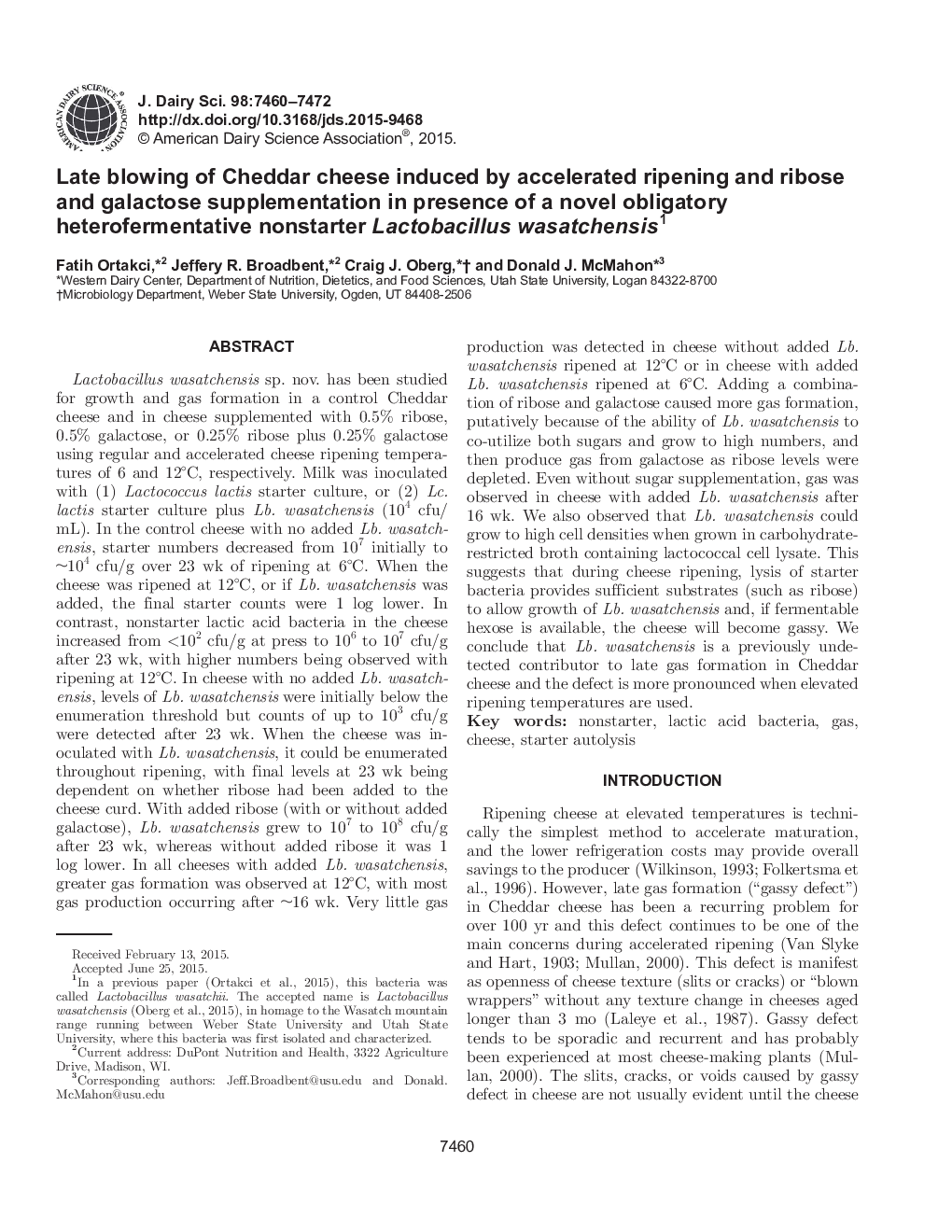| کد مقاله | کد نشریه | سال انتشار | مقاله انگلیسی | نسخه تمام متن |
|---|---|---|---|---|
| 10974495 | 1108026 | 2015 | 13 صفحه PDF | دانلود رایگان |
عنوان انگلیسی مقاله ISI
Late blowing of Cheddar cheese induced by accelerated ripening and ribose and galactose supplementation in presence of a novel obligatory heterofermentative nonstarter Lactobacillus wasatchensis1
ترجمه فارسی عنوان
دمیدن از پنیر چدار که ناشی از رسوب شتابدهنده و ریبوز و مکمل گالاکتوز در حضور یک لاکتوباسیلوس ایزوتچنسی 1
دانلود مقاله + سفارش ترجمه
دانلود مقاله ISI انگلیسی
رایگان برای ایرانیان
موضوعات مرتبط
علوم زیستی و بیوفناوری
علوم کشاورزی و بیولوژیک
علوم دامی و جانورشناسی
چکیده انگلیسی
Lactobacillus wasatchensis sp. nov. has been studied for growth and gas formation in a control Cheddar cheese and in cheese supplemented with 0.5% ribose, 0.5% galactose, or 0.25% ribose plus 0.25% galactose using regular and accelerated cheese ripening temperatures of 6 and 12°C, respectively. Milk was inoculated with (1) Lactococcus lactis starter culture, or (2) Lc. lactis starter culture plus Lb. wasatchensis (104 cfu/mL). In the control cheese with no added Lb. wasatchensis, starter numbers decreased from 107 initially to ~104 cfu/g over 23 wk of ripening at 6°C. When the cheese was ripened at 12°C, or if Lb. wasatchensis was added, the final starter counts were 1 log lower. In contrast, nonstarter lactic acid bacteria in the cheese increased from <102 cfu/g at press to 106 to 107 cfu/g after 23 wk, with higher numbers being observed with ripening at 12°C. In cheese with no added Lb. wasatchensis, levels of Lb. wasatchensis were initially below the enumeration threshold but counts of up to 103 cfu/g were detected after 23 wk. When the cheese was inoculated with Lb. wasatchensis, it could be enumerated throughout ripening, with final levels at 23 wk being dependent on whether ribose had been added to the cheese curd. With added ribose (with or without added galactose), Lb. wasatchensis grew to 107 to 108 cfu/g after 23 wk, whereas without added ribose it was 1 log lower. In all cheeses with added Lb. wasatchensis, greater gas formation was observed at 12°C, with most gas production occurring after ~16 wk. Very little gas production was detected in cheese without added Lb. wasatchensis ripened at 12°C or in cheese with added Lb. wasatchensis ripened at 6°C. Adding a combination of ribose and galactose caused more gas formation, putatively because of the ability of Lb. wasatchensis to co-utilize both sugars and grow to high numbers, and then produce gas from galactose as ribose levels were depleted. Even without sugar supplementation, gas was observed in cheese with added Lb. wasatchensis after 16 wk. We also observed that Lb. wasatchensis could grow to high cell densities when grown in carbohydrate-restricted broth containing lactococcal cell lysate. This suggests that during cheese ripening, lysis of starter bacteria provides sufficient substrates (such as ribose) to allow growth of Lb. wasatchensis and, if fermentable hexose is available, the cheese will become gassy. We conclude that Lb. wasatchensis is a previously undetected contributor to late gas formation in Cheddar cheese and the defect is more pronounced when elevated ripening temperatures are used.
ناشر
Database: Elsevier - ScienceDirect (ساینس دایرکت)
Journal: Journal of Dairy Science - Volume 98, Issue 11, November 2015, Pages 7460-7472
Journal: Journal of Dairy Science - Volume 98, Issue 11, November 2015, Pages 7460-7472
نویسندگان
Fatih Ortakci, Jeffery R. Broadbent, Craig J. Oberg, Donald J. McMahon,
